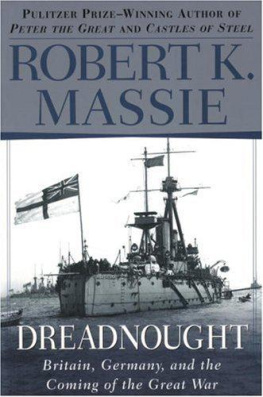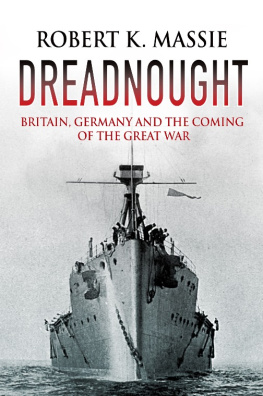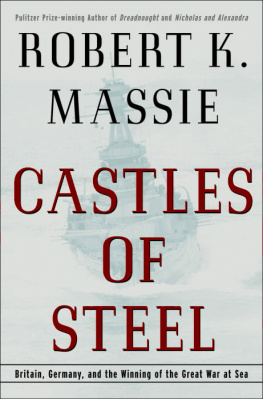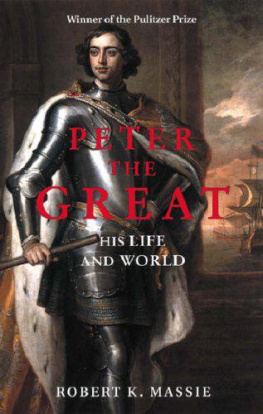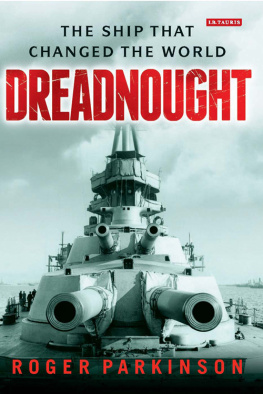Robert K. Massie - Dreadnought, Britain, Germany and the Coming of the Great War
Here you can read online Robert K. Massie - Dreadnought, Britain, Germany and the Coming of the Great War full text of the book (entire story) in english for free. Download pdf and epub, get meaning, cover and reviews about this ebook. year: 1993, publisher: London : Jonathan Cape, 1992., genre: History. Description of the work, (preface) as well as reviews are available. Best literature library LitArk.com created for fans of good reading and offers a wide selection of genres:
Romance novel
Science fiction
Adventure
Detective
Science
History
Home and family
Prose
Art
Politics
Computer
Non-fiction
Religion
Business
Children
Humor
Choose a favorite category and find really read worthwhile books. Enjoy immersion in the world of imagination, feel the emotions of the characters or learn something new for yourself, make an fascinating discovery.
- Book:Dreadnought, Britain, Germany and the Coming of the Great War
- Author:
- Publisher:London : Jonathan Cape, 1992.
- Genre:
- Year:1993
- Rating:5 / 5
- Favourites:Add to favourites
- Your mark:
- 100
- 1
- 2
- 3
- 4
- 5
Dreadnought, Britain, Germany and the Coming of the Great War: summary, description and annotation
We offer to read an annotation, description, summary or preface (depends on what the author of the book "Dreadnought, Britain, Germany and the Coming of the Great War" wrote himself). If you haven't found the necessary information about the book — write in the comments, we will try to find it.
Dreadnought, Britain, Germany and the Coming of the Great War — read online for free the complete book (whole text) full work
Below is the text of the book, divided by pages. System saving the place of the last page read, allows you to conveniently read the book "Dreadnought, Britain, Germany and the Coming of the Great War" online for free, without having to search again every time where you left off. Put a bookmark, and you can go to the page where you finished reading at any time.
Font size:
Interval:
Bookmark:
Table of Contents
DREADNOUGHT
Britain, Germany, and the Coming of the Great War
Robert K. Massie
JONATHAN CAPE LONDON
First published in Great Britain 1992 Reprinted 1992
Jonathan Cape, 20 Vauxhall Bridge Road, London swiv 2sa Robert K. Massie 1991
Robert K. Massie has asserted his right to be identified as the author of this work
A CIP catalogue record for this book is available from the British Library isbn 0-224-03260-7
Printed and bound in Great Britain by Mackays of Chatham plc, Chatham, Kent
For Kim Massie, Jack May, Charles Davis, and Edmund Keeley
AMICIS A IUVENIBUS
The supremacy of the British Navy was stamped indelibly on the history of the nineteenth century during a single terrible afternoon in October 1805 . Between noon and four-thirty p.m. on October 21, in a light wind and rolling Atlantic swell off the coast of Spain, twenty-seven line-of-battle sailing ships commanded by Vice Admiral Lord Horatio Nelson annihilated a combined French and Spanish fleet of thirty-three ships-of-the-line under French Admiral Pierre Villeneuve. The battle took place in a small patch of ocean not more than two miles on each side, a few miles offshore between the port of Cadiz and the western end of the Strait of Gibraltar. The nearest map reference, a remote coastal bay, was to give the battle its name. The bay was called Trafalgar.
Nelson's victory that autumnal afternoon established a supremacy at sea which lasted a century and gave most of the world's great nations a period of relative calm known as the Pax Britannica. Both the naval supremacy and the peace endured while warships changed beyond recognition: wooden hulls were transformed to iron and steel; masts disappeared as sail gave way to steam; bottle-shaped, muzzle-loading guns were replaced by powerful, turret-mounted naval rifles of far greater range and accuracy. Something else remained constant as well: through all those years British seamen exuded a confidence higher than arrogance, an assurance that was bred and passed along by the seventeen thousand men who served at Trafalgar in Nelson's oak-hulled leviathans.
Trafalgar was fought because a mighty Continental state ruled by a conquerer, Napoleon Bonaparte, threatened the security and interests of England. The British Fleet attacked its enemy that day, bearing down on Villeneuve's worried captains with serene and implacable purpose, but the strategic role of the Royal Navy, then as always, was defensive. Historically, the mission of the British Fleet has been to protect the Home Islands from invasion and to guard the trade routes and colonies of the Empire. During the summer of 1805 , the Emperor Napoleon assembled on the cliffs of Boulogne an army of 130,000 veterans to invade and subdue his English foe. The Emperor needed only a brief period of freedom of movement on the English Channel, time enough to transport his battalions across the twenty miles of water so that they could seize London and dictate peace. During their passage, the hundreds of flat-bottomed barges and small vessels collected along the coast to transport the army needed protection from the guns of the British Fleet. This protection could be provided only if Napoleon's own French Fleet, combined with the ships of France's reluctant ally, Spain, could at least briefly take control of the Channel. To block the Emperor's design and prevent the invasion of their homeland was the task of Britain's seamen.
They did so by performing one of the most remarkable feats of sustained seamanship in the annals of maritime history. Overwhelming as the victory at Trafalgar was, the battle was only the thunderous climax to an unparalleled nautical achievement. For two years before Trafalgar, the British Fleet remained continuously at sea off the coasts of Europe. Napoleon's fleet, broken into squadrons, was scattered in harbors from Brest on the Atlantic to Toulon in the Mediterranean. Britain's safety lay in preventing these squadrons from combining in sufficient numbers to force their way into the Channel and clear the way for passage of the Emperor's army into England. And so, for two years, the British Fleet watched and waited outside the ports of Europe; watching to see whether the enemy ships were raising sail and coming out, waiting to destroy them when they did. The blockade was maintained by fifty to sixty British ships-of-the-line, each vessel holding six hundred to nine hundred bored, lonely, hungry, weather-beaten men, lying at night in hammocks slung over their silent, waiting guns. For two years, the ships had been at sea, in the stifling heat and glassy calms of summer, in the gale winds, mountainous seas, and bitter cold of winter. They saw land rarely, touched it almost never. On the blockade, Nelson had spent two years without setting foot off the decks of his flagship, H.M.S. Victory. For twenty-two months, Admiral Lord Cuthbert Collingwood, Nelson's second in command, had not heard the splash of his flagship's anchor. It was the blockade fleet and its success in stalemating the Emperor at Boulogne that Admiral Alfred Thayer Mahan described when he wrote: "those far distant, storm-beaten ships, upon which the Grand Army never looked, stood between it and the dominion of the world."
Now, an angry, impatient Emperor had ordered his fleet to come out and sail for the Channel. The bulk of the fleet was at Cadiz, watched by an English fleet commanded by the idol of the British Navy and the hero of all England. Horatio Nelson was small, slight, and battered; one arm and one eye had already been given in the service of his country. He had other human frailties: he had abandoned his own wife to live openly with a lusty young woman, herself married to an elderly man who had given Nelson his unstinting friendship. Nelson disobeyed Admiralty orders when they did not suit him and he became seasick in bad weather. But his kindness and compassion already were legend, and his skill in battle has never been equalled. Every man in the British Fleet loved him and would follow wherever he led. Nelson's death at the moment of victory blurred triumph and tragedy. When the news reached England, the nation swayed dizzily between celebration and mourning.
Nelson's instructions, as the two fleets sailed slowly towards each other on a gentle morning breeze, were-as always-to attack. Recognizing that in the confusion of battle specific plans would go awry, he concluded his memorandum to his captains: "No captain can do very wrong who places his ship alongside that of an enemy." Implicit in this command was the assumption that any British ship could defeat any opposing enemy ship. Nelson's supreme confidence in British seamanship, British gunnery, and British courage was another legacy of Trafalgar.
Nelson divided his fleet into two divisions with himself in H.M.S. Victory and Collingwood in H.M.S. Royal Sovereign. At the head of his division, Nelson steered his flagship straight at the center of the French line. At noon, the guns began to speak. Four hours of massive carnage were to follow. The lightness of the wind left the smoke of the cannonades hanging in thick curtains over the sea. Through these shrouds, ships would suddenly loom upon each other at close range, firing broadsides and then colliding, hugging each other in a hellish embrace. Cumbersome and slow, they drifted entangled while the men on one ship tried to kill the men on the other. At point-blank range of five yards, fifty guns would thunder and fifty heavy cannon-balls would smash into the timbers of the adjacent ship. Huge masts crashed to the deck, bringing down sails, spars, and lines across both ships and over the sides to trail in the water. On the main decks and in what remained of the rigging, marines fired muskets and cannon loaded with grape, sweeping the enemy's deck, covering it with rows of bodies, filling the scuppers with blood. Sometimes, when all the masts were down and the main deck empty, the men on the gun decks below continued oblivious, loading their cannon, running them out, depressing the muzzles to shoot through the hull or raising them to shoot through the upper decks of the opponent alongside. No matter how badly damaged their ships, Nelson's captains were relentless. Some British ships with masts down and rigging shot away still managed to rig temporary sails, gaining maneuverability to seek new enemies.
Next pageFont size:
Interval:
Bookmark:
Similar books «Dreadnought, Britain, Germany and the Coming of the Great War»
Look at similar books to Dreadnought, Britain, Germany and the Coming of the Great War. We have selected literature similar in name and meaning in the hope of providing readers with more options to find new, interesting, not yet read works.
Discussion, reviews of the book Dreadnought, Britain, Germany and the Coming of the Great War and just readers' own opinions. Leave your comments, write what you think about the work, its meaning or the main characters. Specify what exactly you liked and what you didn't like, and why you think so.

